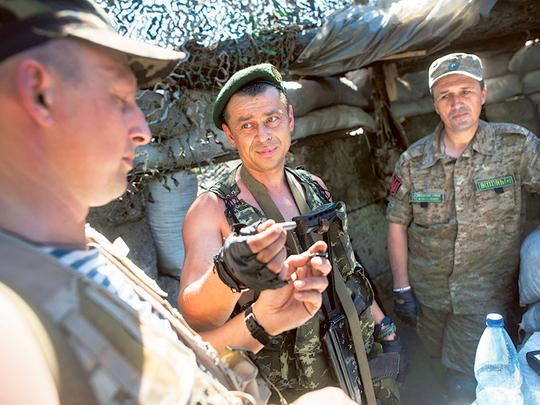
RIGA, Latvia: In a significant move to deter possible Russian aggression in Europe, the Pentagon is poised to store battle tanks, infantry fighting vehicles and other heavy weapons for as many as 5,000 US troops in several Baltic and Eastern European countries, US and allied officials say.
The proposal, if approved, would represent the first time since the end of the Cold War that the United States has stationed heavy military equipment in the newer Nato member nations in Eastern Europe that had once been part of the Soviet sphere of influence. Russia’s annexation of Crimea and the war in eastern Ukraine have caused alarm and prompted new military planning in Nato capitals.
It would be the most prominent of a series of moves the United States and Nato have taken to bolster forces in the region and send a clear message of resolve to allies and to Russia’s president, Vladimir Putin, that the United States would defend the alliance’s members closest to the Russian frontier.
After the expansion of Nato to include the Baltic nations in 2004, the United States and its allies avoided the permanent stationing of equipment or troops in the east as they sought varying forms of partnership with Russia.
“This is a very meaningful shift in policy,” said James G. Stavridis, a retired admiral and the former supreme allied commander of Nato, who is now dean of the Fletcher School of Law and Diplomacy at Tufts University. “It provides a reasonable level of reassurance to jittery allies, although nothing is as good as troops stationed full time on the ground, of course.”
The amount of equipment included in the planning is small compared with what Russia could bring to bear against the Nato nations on or near its borders, but it would serve as a credible sign of US commitment, acting as a deterrent the way that the Berlin Brigade did after during the Berlin Wall crisis in 1961.
“It’s like taking Nato back to the future,” said Julianne Smith, a former defence and White House official who is now a senior fellow at the Center for a New American Security and a vice president at the consulting firm Beacon Global Strategies.
The “pre-positioned” stocks — to be stored on allied bases and enough to equip a brigade of 3,000 to 5,000 soldiers — would be similar to what the United States maintained in Kuwait for more than a decade after Iraq invaded it in 1990 and was expelled by US and allied forces early the next year.
The Pentagon’s proposal still requires approval by Defense Secretary Ash Carter and the White House. And political hurdles remain, as the significance of the potential step has stirred concern among some Nato allies about Russia’s reaction to a build-up of equipment.
“The US military continues to review the best location to store these materials in consultation with our allies,” said Col. Steven H. Warren, a Pentagon spokesman. “At this time, we have made no decision about if or when to move to this equipment.”
Senior officials briefed on the proposals, and who described the internal military planning on the condition of anonymity, said that they expected approval to come before the Nato defence ministers’ meeting in Brussels this month.
The proposal falls short of permanently assigning US troops to the Baltics — something senior officials of those countries recently requested in a letter to Nato. Even so, officials in those countries say they welcomed the proposal to ship at least the equipment forward.
“We need the pre-positioned equipment because if something happens, we’ll need additional armaments, equipment and ammunition,” Raimonds Vejonis, Latvia’s defence minister, said in an interview at his office here last week.
“If something happens, we can’t wait days or weeks for more equipment,” said Vejonis, who will become Latvia’s president in July. “We need to react immediately.”
Mark Galeotti, a professor at New York University who has written extensively on Russia’s military and security services, noted, “Tanks on the ground, even if they haven’t people in them, make for a significant marker.”
As the proposal stands now, a company’s worth of equipment — enough for about 150 soldiers — would be stored in each of the three Baltic nations: Lithuania, Latvia and Estonia. Enough for a company or possibly a battalion — about 750 soldiers — would be located in Poland, Romania, Bulgaria and possibly Hungary, they said.
— New York Times News Service












